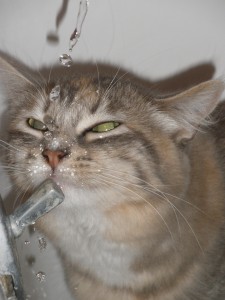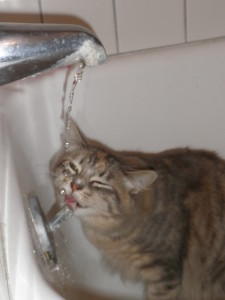
Cats don’t like water.
Our cat sitters have told us that Lily has a drinking problem. She drinks a lot of water and has since she was a wee kitten. There’s a reason for this—she has kidney disease. She’s being treated through her diet and so far, according to the frequent testing, she’s holding her own.
Lily also has a fascination for water and likes to play in it. She doesn’t even mind getting a few sprinkles on her face while drinking out of the faucet, her water fountain, my glass of water, her water bowls, or any other vessel of water she happens upon. Obviously, the well-known premise that cats hate water doesn’t apply to Lily.
Our white odd-eye cat, Winfield was addicted to water, as well. He didn’t drink as much as
Lily does, but he’d play in it. We finally had to buy heavy pottery water bowls that he

OLYMPUS DIGITAL CAMERA
couldn’t tip over. He’d still move them around, though because he couldn’t keep his paws out of the water. He actually used his paw to drink. He’d dip his paw into the water and lick the water off. Then dip it again and lick it, until he’d had his fill of water.
It’s not uncommon for wild cats to make friends with bodies of water—go swimming in a pond, for example, or simply cool off in a puddle or a lake. The Asian fishing cat is known to be a skilled swimmer. He even has webbed paws and most of them are adept at catching their meals in the water—hence their name—fishing cat.
Domestic cats bred from wild strains of wild cats also tend to gravitate toward water—the Bengal (from the Asian leopard cat), the Savannah (from the African serval), and the Chausie (from the Asian jungle cat), for example. The Maine coon and the Norwegian forest cat are also known to like water, as does the Turkish van—known as the swimming cat.
Who knows, the next kitten or cat you adopt just might be a water baby if you don’t force him into a bath or spray him with water as punishment. That might discourage him from enjoying a dip or a squirt.





